God Help Us... The Mini-500 Shows Up At Wittman
By ANN Correspondent Kevin "Hognose" O'Brien
The rotorcraft area was real thin at Oshkosh. Actually, if you
haven't been there, you know that there is no rotorcraft area; just
a corner of the ultralight area, which was also sparsely populated
this year.
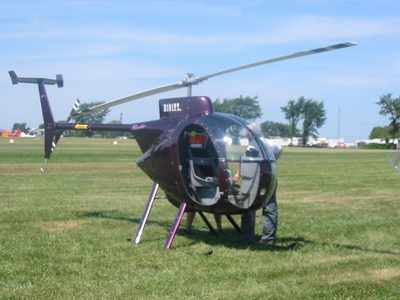
The two big guns in rotorcraft, RAF 2000 and Rotorway, were away
in the main display area, along with certified helicopter vendors
including Enstrom and Robinson. There were several clean Rotorway
Execs flying, but no RAF gyros (however, prospects could get a ride
in an RAF at nearby fields, ringing up a half-hour with a gyro CFI
for a nominal sum). Alongside the Rotorways on the flightline was a
lonely Magni gyro, and three businesslike Safaris,
and…what's this? A Mini-500?
When the Mini-500 started up, there was a second shock. Instead
of the buzz of an overtaxed Rotax, the whistle of a turbine greeted
us.
The Sad History of the Mini-500
Now, there has been neither hide nor hair of a Mini-500 around
these parts for years, and for good reason. The Mini looked great
and was well-promoted, but it was underengineered and the quality
control on the kits was horrible. While the company, Revolution
Helicopter Company Incorporated (RHCI) basked in the initial good
press, the dreams of many owners soon took a nightmare turn. Some
machines never did balance properly. Some rotor blades were
deformed. Then frames started cracking.
Then the accidents began
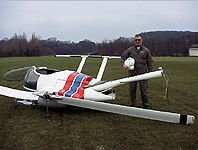 The engine, asked to do more than it could, would
stop; the nose would tuck; an inexperienced helo pilot would do the
wrong thing and, BANG. About 500 Minis were sold. About 200 to 300
flew. Some 70 had accidents, including about ten fatals. Better
odds than Russian roulette… just.
The engine, asked to do more than it could, would
stop; the nose would tuck; an inexperienced helo pilot would do the
wrong thing and, BANG. About 500 Minis were sold. About 200 to 300
flew. Some 70 had accidents, including about ten fatals. Better
odds than Russian roulette… just.
Several characteristics of the helicopter combined to make it
deadly. The overloaded engine was prone to sudden stoppage, the
rotor had lower inertia than many copters, and the nose tuck was
alarming. These combined to make an autorotation both rather
likely, and very difficult for an inexperienced helicopter pilot to
handle. Indeed, the Mini could be a handful for an experienced
pilot - one of the victims had well over 30,000 helicopter
hours.
The developer of the machine, cornered, began lashing out at his
critics, including many of his customers. He was taking deposits
for a two-seater machine (that never properly flew) and,
unbeknownst to his customers, defaulting on an SBA loan. He got
some snowmobile racers to build a custom exhaust pipe to wring more
power from the motor (these same guys were also his engine
experts). He told the customer he was selling the pipe at cost. He
was making about $650 on each $900 exhaust kit.
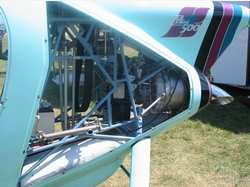 Meanwhile, he turned on and sued a man working on
a turbine conversion. But the crashes continued, and the machine's
reputation worsened. A builders' association formed, and was
instantly at sword's point with the developer. Finally, despite a
last minute PR blitz that led to a puff piece in Kitplanes
whitewashing the Mini's problems, the beleaguered firm went under.
The developer changed his name and fled the country (he has since
returned). The SBA seized the factory and sold off the parts and
tooling. The parts went to China, but without the tooling the
Chinese can't build the copters. Where's the tooling? Hang on and
I'll tell you…
Meanwhile, he turned on and sued a man working on
a turbine conversion. But the crashes continued, and the machine's
reputation worsened. A builders' association formed, and was
instantly at sword's point with the developer. Finally, despite a
last minute PR blitz that led to a puff piece in Kitplanes
whitewashing the Mini's problems, the beleaguered firm went under.
The developer changed his name and fled the country (he has since
returned). The SBA seized the factory and sold off the parts and
tooling. The parts went to China, but without the tooling the
Chinese can't build the copters. Where's the tooling? Hang on and
I'll tell you…
So… Is it Back?
Back in Oshkosh, in the here and now, a helicopter is flying.
It's a turbine Mini, and it looks good. It's quiet, and quick, and
the pilot has it completely under control. He's having fun. Is the
Mini-500 back from the dead?
If it is, the guy responsible is Rick Stitt. Rick is an engineer
who worked with Revolution to try to fix the Mini's problems.
Dismissed from the failing company, he continued to work with Mini
customers to try to keep them safe and flying, even after the
company collapsed. Finally, at the SBA auction, Rick bought a
number of the tools and some of the inventory of
RHCI.
Rick's main product these days is a turbine conversion for the
Mini. Based on a Solar APU, it solves the sudden-stoppage and
vibration problems that plagued the machine. It also solves another
problem, low power. Some have been critical of the use of APUs as
propulsion units. Stitt thinks his selection is good. The
particular dash-number he uses is used as a CH-47 APU by the
military and runs continuously while the helicopter is running.
It's also lighter than the GPU versions that some turbine promoters
use. As Rick puts it, "It was built to fly. Some of those others
aren't."
The Solar installation in the Mini looks neat, tidy and
altogether "factory." This photo of an incomplete installation will
give you an idea of how it fits in.
Rick sells the turbine kit for a very attractive price. But you
can't just buy a kit. You have to bring yourself and your Mini to
Rick's shop, where he'll inspect it and spend a day or two fixing
things that either you, or the original factory, did wrong. Then he
aligns the rotating assemblies, and installs the motor and other
new parts. You only get turned loose when he figures it's safe.
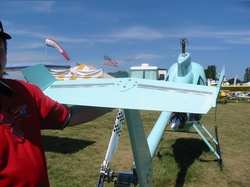 His other main activity is service, in which guise
he has solutions to many of the other problems. The frame is beefed
up to banish the frame cracking that plagued Minis. A stall strip
on the tail, Stitt swears, is all that was needed to end the nasty
nose tuck. He obligingly grabbed a Mini's tail boom and pulled the
tail down for a photo.
His other main activity is service, in which guise
he has solutions to many of the other problems. The frame is beefed
up to banish the frame cracking that plagued Minis. A stall strip
on the tail, Stitt swears, is all that was needed to end the nasty
nose tuck. He obligingly grabbed a Mini's tail boom and pulled the
tail down for a photo.
At any given moment Rick has a dozen or more Mini-500s in his
shop, for updates, modifications, safety enhancements or
inspections. He'll also broker Mini-500 deals between buyers and
sellers. Right now, their orphan status has helped keep Mini prices
depressed. They may not stay that way if word gets out that support
is available (and probably better support than the factory ever
provided).
Kit Production… a Possibility
The Mini-500 is a new machine with Stitt's turbine. Maybe it's
finally tamed, although the jury might take a while to come in on
that one. But with so many fixes in hand, and most of the tooling,
has Rick thought about making new kits?
"I've thought about it, yeah. I'm about fifteen parts short of a
complete ship set, so I would have to tool up to make those fifteen
parts." But the possibility is there, if demand warrants.
But what about the rights? One of the reasons Rick didn't
last with Revolution is that the paranoid boss suspected him of
planning to launch a competitive helicopter kit. Now, in a moment
laden with irony, Rick is on the brink of doing what he was
unjustly accused of doing before.
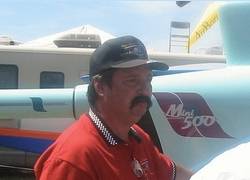 Rick isn't worried about being sued. The design
was part of the security of the SBA loan. Yet it doesn't appear to
have been sold at the auction. So it seems that the design from
which Rick's kits would be derived (with changes to the frame,
rotors, and powerplant, it's hardly the same machine) is arguably
the property of the Small Business Administration.
Rick isn't worried about being sued. The design
was part of the security of the SBA loan. Yet it doesn't appear to
have been sold at the auction. So it seems that the design from
which Rick's kits would be derived (with changes to the frame,
rotors, and powerplant, it's hardly the same machine) is arguably
the property of the Small Business Administration.
Will it Work?
Despite Stitt's enthusiasm and talent, he has an uphill battle
against the machine's widowmaker reputation ahead of him. A few
days after the end of the show, a pilot posted a wanted ad on the
internet, seeking a Mini-500. His ad began, "Suicidal Maniac
looking for the best buy on a undamaged Mini."
At press time it was unknown whether he had heard from The
Samaritans. Or Rick.
 Aero-News: Quote of the Day (04.28.25)
Aero-News: Quote of the Day (04.28.25) ANN's Daily Aero-Term (04.28.25): Decision Altitude (DA)
ANN's Daily Aero-Term (04.28.25): Decision Altitude (DA) ANN's Daily Aero-Linx (04.28.25)
ANN's Daily Aero-Linx (04.28.25) Airborne-Flight Training 04.24.25: GA Refocused, Seminole/Epic, WestJet v TFWP
Airborne-Flight Training 04.24.25: GA Refocused, Seminole/Epic, WestJet v TFWP Aero-News: Quote of the Day (04.29.25)
Aero-News: Quote of the Day (04.29.25)







